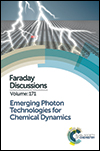How fast can a Peierls–Mott insulator be melted?
Abstract
Time- and angle-resolved extreme ultraviolet photoemission spectroscopy is used to directly determine the momentum-dependent electronic structure dynamics in the layered Peierls–Mott insulators 1T-TaS2 and 1T-TaSe2 on the sub-300 fs time scale. Extracted spectroscopic order parameters display a global two-time-scale dynamics indicating a quasi-instantaneous loss of the electronic orders and a subsequent coherent suppression of the lattice distortion on a time scale related to the frequency of the charge-density–wave amplitude mode. After one half-cycle of coherent amplitude-mode vibration, a crossover state between insulator and metal with partially filled-in and partially closed Mott and Peierls gaps is reached. The results are discussed within the wider context of electronic order quenching in complex materials.
- This article is part of the themed collection: Emerging Photon Technologies for Chemical Dynamics

 Please wait while we load your content...
Please wait while we load your content...